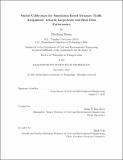| dc.contributor.advisor | Moshe E. Ben-Akiva. | en_US |
| dc.contributor.author | Zhang, Haizheng, Ph. D. Massachusetts Institute of Technology | en_US |
| dc.contributor.other | Massachusetts Institute of Technology. Department of Civil and Environmental Engineering. | en_US |
| dc.date.accessioned | 2019-03-01T19:33:17Z | |
| dc.date.available | 2019-03-01T19:33:17Z | |
| dc.date.copyright | 2018 | en_US |
| dc.date.issued | 2018 | en_US |
| dc.identifier.uri | http://hdl.handle.net/1721.1/120603 | |
| dc.description | Thesis: Ph. D. in Transportation, Massachusetts Institute of Technology, Department of Civil and Environmental Engineering, 2018. | en_US |
| dc.description | This electronic version was submitted by the student author. The certified thesis is available in the Institute Archives and Special Collections. | en_US |
| dc.description | Cataloged from student-submitted PDF version of thesis. | en_US |
| dc.description | Includes bibliographical references (pages 149-152). | en_US |
| dc.description.abstract | The severity of traffic congestion is increasing each year in the US, resulting in higher travel times, and increased energy consumption and emissions. They have led to an increasing emphasis on the development of tools for trac management, which intends to alleviate congestion by more eciently utilizing the existing infrastructure. Eective trac management necessitates the generation of accurate short-term predictions of trac states and in this context, simulation-based Dynamic Trac Assignment (DTA) systems have gained prominence over the years. However, a key challenge that remains to be addressed with real-time DTA systems is their scalability and accuracy for applications to large-scale urban networks. A key component of real-time DTA systems that impacts scalability and accuracy is online calibration which attempts to adjust simulation parameters in real-time to match as closely as possible simulated measurements with real-time surveillance data. This thesis contributes to the existing literature on online calibration of DTA systems in three respects: (1) modeling explicitly the stochasticity in simulators and thereby improving accuracy; (2) augmenting the State Space Model (SSM) to capture the delayed measurements on large-scale and congested networks; (3) presenting a gradient estimation procedure called partitioned simultaneous perturbation (PSP) that utilizes an assumed sparse gradient structure to facilitate real-time performance. The results demonstrate that, first, the proposed approach to address stochasticity improves the accuracy of supply calibration on a synthetic network. Second, the augmented SSM improves both estimation and prediction accuracy on a congested synthetic network and the large-scale Singapore expressway network. Finally, compared with the traditional finite difference method, the PSP reduces the number of computations by 90% and achieves the same calibration accuracy on the Singapore expressway network. The proposed methodologies have important applications in the deployment of real-time DTA systems for large scale urban networks. | en_US |
| dc.description.statementofresponsibility | by Haizheng Zhang. | en_US |
| dc.format.extent | 152 pages | en_US |
| dc.language.iso | eng | en_US |
| dc.publisher | Massachusetts Institute of Technology | en_US |
| dc.rights | MIT theses are protected by copyright. They may be viewed, downloaded, or printed from this source but further reproduction or distribution in any format is prohibited without written permission. | en_US |
| dc.rights.uri | http://dspace.mit.edu/handle/1721.1/7582 | en_US |
| dc.subject | Civil and Environmental Engineering. | en_US |
| dc.title | Online calibration for simulation-based dynamic traffic assignment : towards large-scale and real-time performance | en_US |
| dc.type | Thesis | en_US |
| dc.description.degree | Ph. D. in Transportation | en_US |
| dc.contributor.department | Massachusetts Institute of Technology. Department of Civil and Environmental Engineering | |
| dc.identifier.oclc | 1087507806 | en_US |
